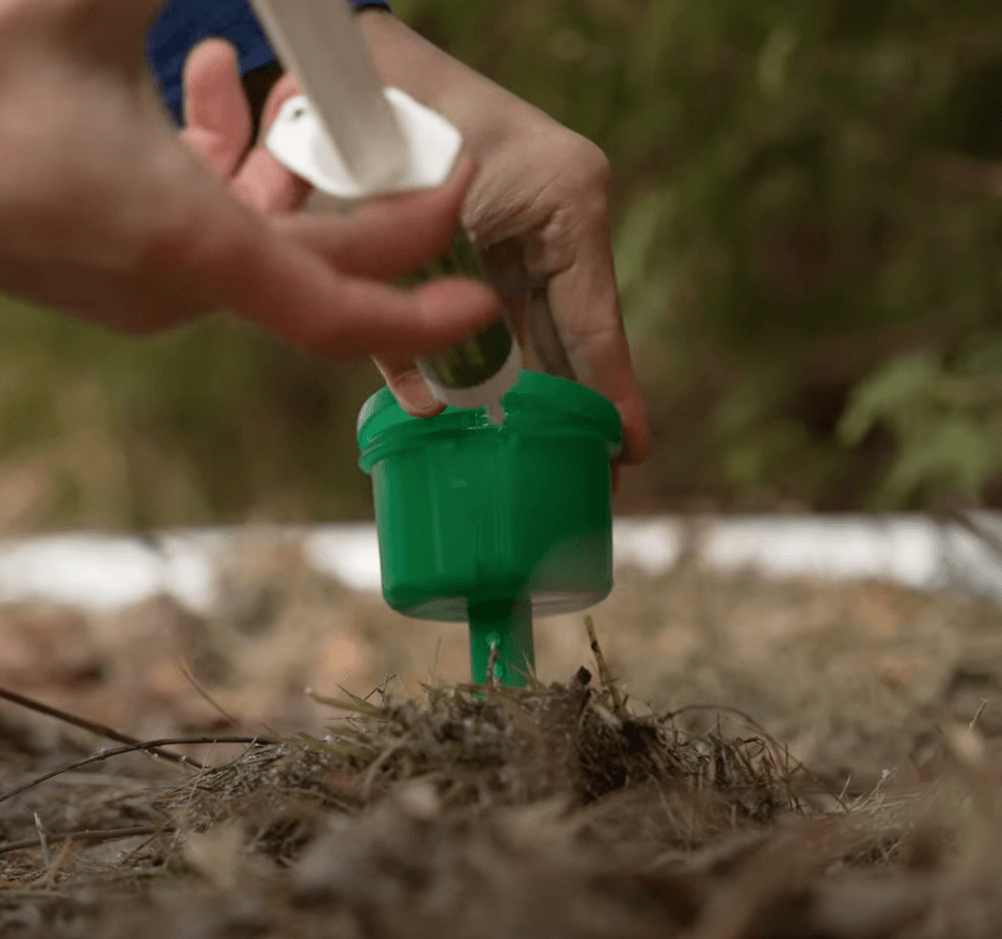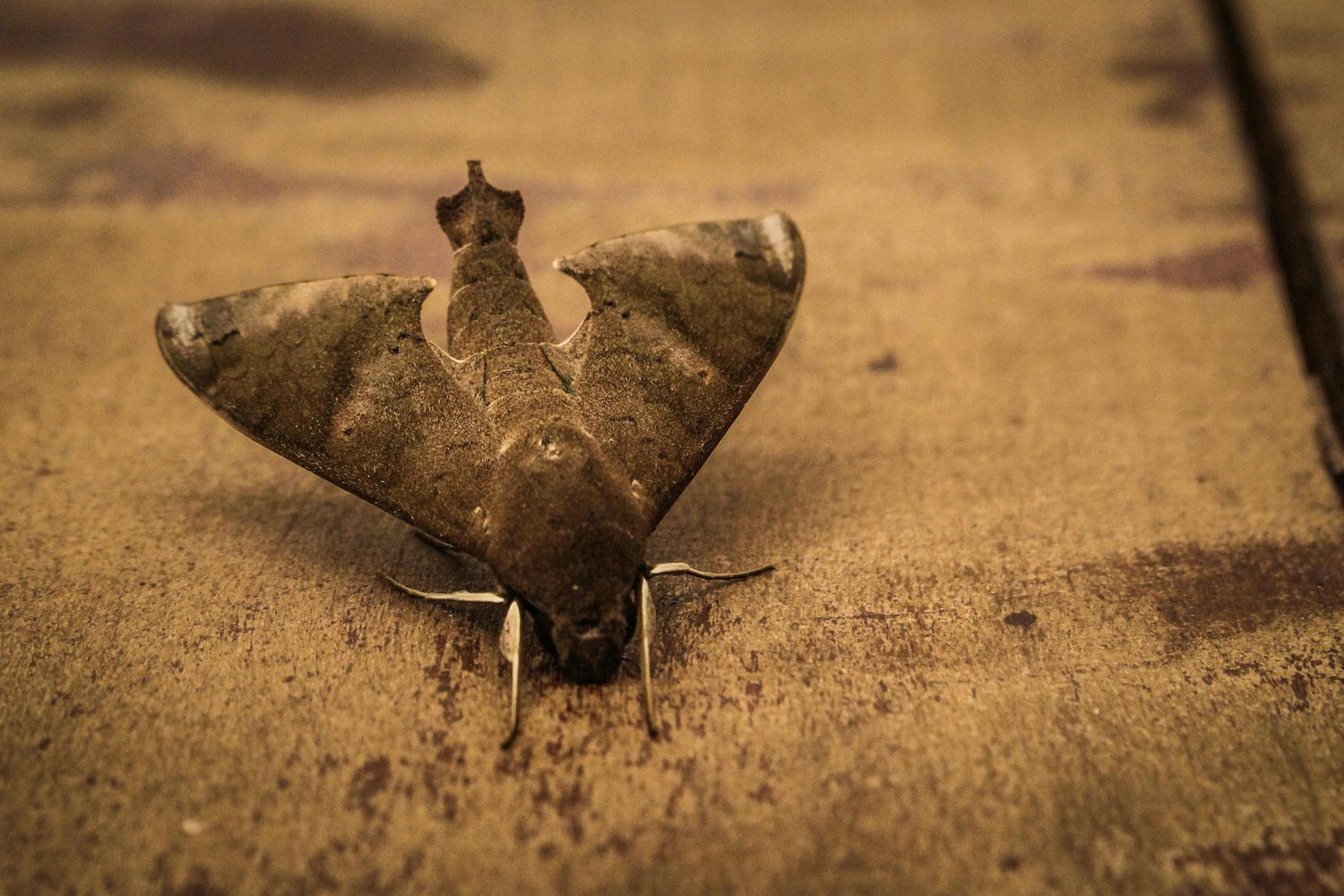
Signs of presence ⌵

General description ⌵

How to get rid of it ⌵

Dangers and damages ⌵
Signs of Food Moths
Identifying the signs of food moths helps prevent their spread and protect your food:
1. Adult moths and their erratic flight
The first sign of a food moth infestation is often the presence of small brown or gray moths flying around the kitchen or pantry. These moths fly erratically, attracted to food sources such as grains and cereals. These adult moths, while not harmful in themselves, are an indication that eggs or larvae are already established nearby.
2. Presence of larvae and cocoons
The larvae, which cause the vast majority of damage, can be seen in food packaging. They appear as small white worms that feed on grains, flour, and even pet food. It is common to find cocoons in the corners of food bags or boxes, as well as silken tubes on the surface of infested products. These cocoons, created by the larvae, can also cling to the walls of shelves and containers.
3. Small holes and debris
Food moth larvae are able to bore through thin plastic bags and cardboard boxes, creating small holes that are visible to the naked eye. Around these holes or on surrounding surfaces, it is common to find tiny grains of dust-like material or food fragments, known as "frass" (larval excrement). This often contributes to unsanitary conditions in packaging or on shelves, especially if moths have multiplied in specific areas.
4. Unpleasant odor and clumps of stuck grains
An advanced infestation may also be accompanied by a musty odor in the pantry. This odor comes from the rotting larvae and their droppings. Sometimes, grains such as rice or flour clump together due to the sticky secretions of the larvae, forming clumps in the affected packaging.
5. Webs in the corners of the containers
Finally, food moths often leave webs in the corners of packages or around containers that hold food. These webs, similar to very fine silk threads, are found in the corners or around the seams of packages and are a classic sign of their presence. A careful inspection of bags, boxes and containers can help you spot these subtle clues and take steps to eliminate the moths before the infestation becomes serious.
General description of food moths
Food moths, often called “pantry moths,” are small, noxious insects that infest dry foods like cereal, flour, nuts, seeds, dried fruits, and even pet food. The most common food moth is the Indian Meal Moth, which is recognizable by its grayish-brown body and copper-speckled wings. Adults are about 1.5 cm long and have a zigzag flight pattern, making them easy to spot in kitchens and pantries.
The life cycle of food moths begins with the laying of eggs on or near food products. The eggs hatch within a few days, releasing larvae that can pierce paper and plastic packaging to access food. The larvae, small white caterpillars, are the main cause of damage, contaminating products with silk threads, excrement and molt remains. The larval phase can last from a few weeks to several months depending on the temperature and availability of food, then they transform into pupae before reaching adulthood, completing their life cycle in 2 to 3 months.
To prevent food moth infestations, it is advisable to store dry goods in airtight glass or metal containers, as the larvae can pierce thin plastic packaging. In the event of an infestation, it is essential to discard all contaminated products, thoroughly clean shelves and corners, and disinfect storage areas to remove residual eggs. Pheromone traps can also be used to attract and capture adult males, helping to reduce moth populations.
How to Get Rid of Food Moths
Food moths, also known as produce moths, are common pests in pantries and kitchens. These small insects prey on dry foods like grains, flours, pasta, nuts, and pet food. To prevent their presence from becoming a major infestation, here are the steps to effectively eliminate food moths.
1. Empty and inspect the pantry
The first step is to completely empty your pantry and inspect each food item. Look for signs of infestation such as webbing , larvae ( which look like small white worms), or holes in packaging . Immediately dispose of all infested food in a tightly sealed plastic bag and place it in an outdoor trash can.
2. Deep clean
Use a vacuum cleaner to clean all shelves, paying special attention to corners and crevices where eggs can hide. Then, wash all surfaces with a solution of white vinegar and warm water to disinfect and repel moths.
3. Store food properly
To prevent reinfestation, store all dry foods in airtight glass or hard plastic containers . Moths cannot enter or exit these containers, limiting damage. It is also a good idea to freeze recently purchased foods for a few days before storing them in your pantry, to kill any potential larvae.
4. Use pheromone traps
Pheromone traps are very effective in capturing male moths and interrupting their breeding cycle. These non-toxic traps can be placed in the pantry to control the remaining population after cleaning. You can find such professional-quality traps at the online exterminator .
5. Long-term prevention
Finally, be sure to clean your pantry regularly , especially after food spills. Don't store dry foods for too long, and use the "first in, first out" method to avoid keeping perishable items too long.
By following these steps, you can effectively get rid of food moths and prevent them from re-infesting your groceries.
The dangers and damage caused by food moths
Food moths, also called pantry moths, pose a risk primarily to food safety rather than human health. They grow rapidly in food storage and are capable of contaminating dry goods, often rendering these foods unsafe to eat.
Risks of contamination
Food moth larvae consume a variety of dry goods, including grains, flours, dried fruits, spices, and pet foods. Once there, the larvae leave residues, such as webbing and droppings, in the infested food. These contaminants make the food unsuitable for consumption because it may contain mold or secondary bacteria due to the buildup of organic waste. Moths lay their eggs directly on or in the food, which allows the infestation to spread quickly throughout the pantry if not controlled quickly.
Material damage
Moth larvae can penetrate paper and plastic packaging, damaging food packaging and contaminating groceries. In addition to visible holes, the larvae often create webs and cocoons in the corners of shelves and around containers, which may require extensive cleaning to completely eliminate the infestation. The need to throw away contaminated food also results in food waste, increasing household expenses.
However, by adopting prevention and control practices, it is possible to reduce the risks of property damage and food waste associated with food moths.
With the purchase of a reusable half-mask respirator , get a 10% discount on the 3M vapor cartridge .
Discount code: 6TZJ
de rabais
10%
With the purchase of a Webster Cobweb brush , get a 10% discount on the Webster Cobweb extendable pole .
Discount code: DTSQ
de rabais
30%
With the purchase of a FlowZone backpack sprayer , get a 30% discount on complementary FlowZone products .
Discount code: A29B
de rabais
25%
With the purchase of the Catchmaster Ovi-Planter Ago mosquito trap , get a 25% discount on an Ungava brand mosquito repellent .
Discount code: UH5T
de rabais
25%
With the purchase of the Catchmaster Ovi-Catch Ago mosquito trap, get a 25% discount on an Ungava brand mosquito repellent .
Discount code: UH5T
de rabais
15%
With the purchase of the Envirolights JR fly light trap , get a 15% discount on the Catchmaster Flylight JR sticky panel .
Discount code: ZN7G
Best Sellers
-
ONGUARD, Pro-perm Domestic Insect Killer 3.78 L
Regular price $39.99 CADRegular priceUnit price per -
ONGUARD, Professional Residual Insecticide P-22 RTU
Regular price $19.99 CADRegular priceUnit price per -
ONGUARD PD 5, Domestic Pressurized Spray for Flying and Crawling Insects
Regular price $27.49 CADRegular priceUnit price per$32.99 CADSale price $27.49 CADSale -
ONGUARD, Total Insect Sprayer 400G
Regular price $11.99 CADRegular priceUnit price per$14.99 CADSale price $11.99 CADSale

Find your solution
Do you have a pest in your home but you don't know what solution to use to get rid of it? Just answer a few questions, and you will get your solution.









